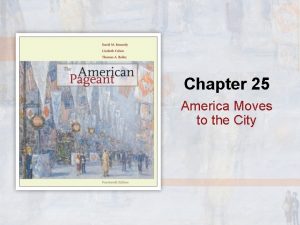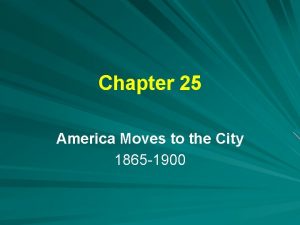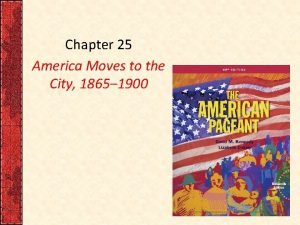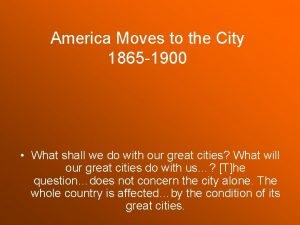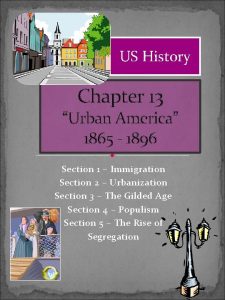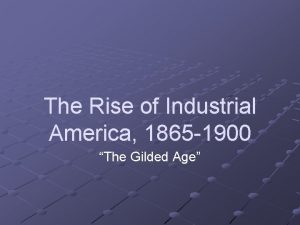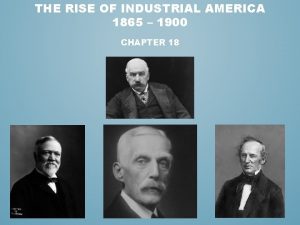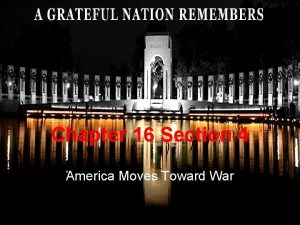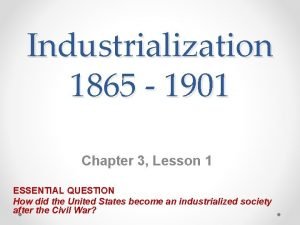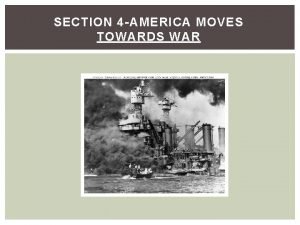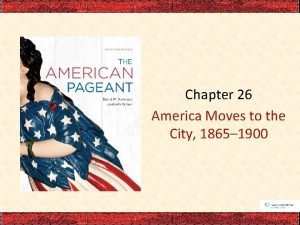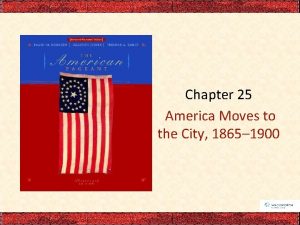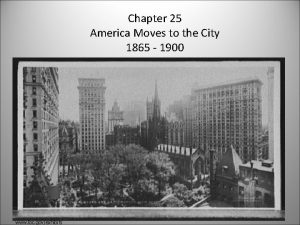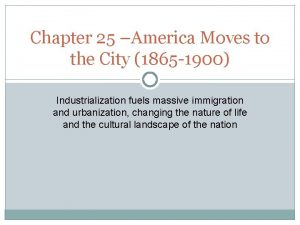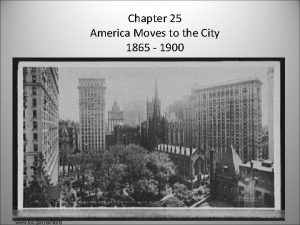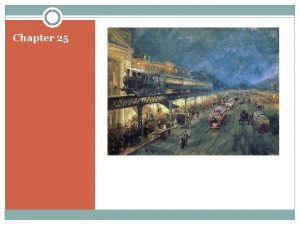Chapter 25 America Moves to the City 1865











- Slides: 11

Chapter 25 America Moves to the City 1865 -1900

The Urban Frontier 1870 -1900 - American population doubled – population in the cities tripled skyscrapers allowed cities to expand upward – first appearing in Chicago (1885), developed by Louis Sullivan Electricity, indoor plumbing, and telephones made city life more alluring – Department stores like Macy’s (in New York) and Marshall Field’s (in Chicago) provided urban working-class jobs and also attracted urban middle-class shoppers – 1883 – Brooklyn Bridge is completed, the suspension bridge is a symbol of American ingenuity Theodore Dreiser captured big-city in his book Sister Carrie – Carrie wants to leave “boring” country life, moves to Chicago – Finds upward mobility by sleeping w/ “important” men – Dreiser was a “realist”, depicts Carrie’s life and Chicago without sugar-coating themes of the story – Country folks could get a taste of the big city as Sears & Montgomery Ward begin business w/ mail order catalogs

move to city produced lots of trash – farmers always reused everything or fed “trash” to animals – city dwellers could simply throw away the things that they didn’t like anymore (just order more) In cities, crime flourished, and impure water, uncollected garbage, unwashed bodies, and droppings made cities smelly and unsanitary Slums were crammed with people – “dumbbell tenements” were the worst since they were dark, cramped, had little sanitation or ventilation – 4 apartments per floor w/ plenty of room; some landlords would treat each room as an apartment – To escape, the wealthy of the citydwellers fled to suburbs

New Immigration Prior to 1880 – “Old Immigration” comes from North & Western Europe – – Britain, Ireland, Germany, Scandinavia Primarily Protestant Democratic & fair-skinned Anglo-Saxon types Generally educated & had some money “New Immigration” comes from South & Eastern Europe – – – Poland, Italy, & Slavic people of the Balkan Penninsula No background in democracy Catholic, uneducated & penniless southeastern Europeans accounted for over 60% of immigrants Reasons for Europeans: – no room, no jobs in Europe – people boasted of eating everyday and having freedom and much opportunity Stories were big to attract cheap labor

Reactions to the New Immigration federal government did little to help immigrants assimilate into American society – often controlled by powerful “bosses” provided jobs and shelter in return for political support at the polls (= corruption) nation’s conscience awoke to the plight of the slums – Walter Rauschenbusch and Washington Gladden began preaching the “social gospel” Jane Addams, founded Hull House in 1889 to teach children and adults the skills and knowledge that they would need to survive and succeed in America – won the Nobel Peace Prize in 1931 Florence Kelley fought for protection of women workers and against child labor – new cities also gave women (mostly single women, since working mothers and wives was considered bad) opportunities to earn money and support themselves better

“Nativism” and Antiforeignism Germans and western Europeans looked down upon the new Slavs and Baltics – fearing that mixing of blood would ruin the fairer Anglo-Saxon races and create inferior offspring “native” Americans blamed immigrants for the degradation of the urban government unionists hated them for their willingness to work for super low wages and for bringing in dangerous doctrines like socialism and communism American Protective Association (APA) arose to go against new immigrants 1882 - Congress passed the first restrictive law against immigration, which banned paupers, criminals, and convicts from coming here 1885 - another law was passed banning the importation of foreign workers under usually substandard contracts

Darwin Disrupts the Churches 1859 - Charles Darwin published his On the Origin of Species new doctrine of evolutionism and attracted the ire and fury of fundamentalists (creation) “Modernists” took a step from the fundamentalists and refused to believe that the Bible was completely accurate and factual

Lust for Learning creation of more public schools and the provision of free textbooks funded by taxpayers 1900 - there were 6, 000 high schools in America; kindergartens also multiplied Americans began to develop a faith in formal education as a solution to poverty Booker T. Washington started a black normal and industrial school in Tuskegee, Alabama – he avoided the issue of social equality – he believed in Blacks helping themselves first before gaining more rights – One of Washington’s students was George Washington Carver, who later discovered hundreds of new uses for peanuts, sweet potatoes, and soybeans – W. E. B. Du. Bois, the first Black to get a Ph. D. from Harvard University, demanded complete equality for Blacks and action now – also founded the National Association for the Advancement of Colored People (NAACP) in 1910

Appeal of the Press Public libraries opened across America, bringing literature into people’s homes – Andrew Carnegie contributed $60 million to build libraries – 1897 – Library of Congress opened & invention of the Linotype in 1885, the press more than kept pace competition sparked a new brand of journalism called “yellow journalism, ” newspapers reported on wild and fantastic stories that often were false or quite exaggerated: sex, scandal, and other human-interest stories. Two new journalistic tycoons emerged: Joseph Pulitzer (New York World) and William Randolph Hearst (San Francisco Examiner, et al. ).

Postwar Writing Americans devoured “dime-novels” which depicted the wild West and other romantic adventure settings – Harland F. Halsey made 650 of these novels – General Lewis Wallace wrote Ben Hur: A Tale of the Christ, which combated the ideas and beliefs of Darwinism and Darwinists – Walt Whitman was one of the old writers who still remained active, publishing revisions of his hardy perennial: Leaves of Grass – Emily Dickinson was a famed hermit of a poet whose poems were published after her death Families and Women in the City Urban life was stressful on families, who often were separated, and everyone had to work—even children as young as ten years old in the cities, more children meant more mouths to feed and a greater chance of poverty

1898 - Charlotte Perkins Gilman published Women and Economics – called for women to abandon their dependent status and contribute to the larger life of the community through productive involvement in the economy – advocated day-care centers and centralized nurseries and kitchens Feminists also rallied toward suffrage – National American Woman Suffrage Association in 1890 Carrie Chapman Catt stressed the desirability of giving women the vote if they were to continue to discharge their traditional duties and homemakers in the increasingly public world of the city Wyoming Territory was the first to offer women unrestricted suffrage in 1869 Other groups also fought for suffrage
 Chapter 25 america moves to the city
Chapter 25 america moves to the city Chapter 25 america moves to the city
Chapter 25 america moves to the city Chapter 25 america moves to the city
Chapter 25 america moves to the city America moves to the city
America moves to the city America moves to the city
America moves to the city Urban america 1865 to 1896
Urban america 1865 to 1896 The rise of industrial america 1865-1900
The rise of industrial america 1865-1900 Four features of industrial manufacturing (1865-1900)
Four features of industrial manufacturing (1865-1900) America moves toward war section 4
America moves toward war section 4 Chapter 24 section 4 america moves toward war
Chapter 24 section 4 america moves toward war Chapter 3 lesson 1 the rise of industry answers
Chapter 3 lesson 1 the rise of industry answers America moves toward war section 4
America moves toward war section 4
